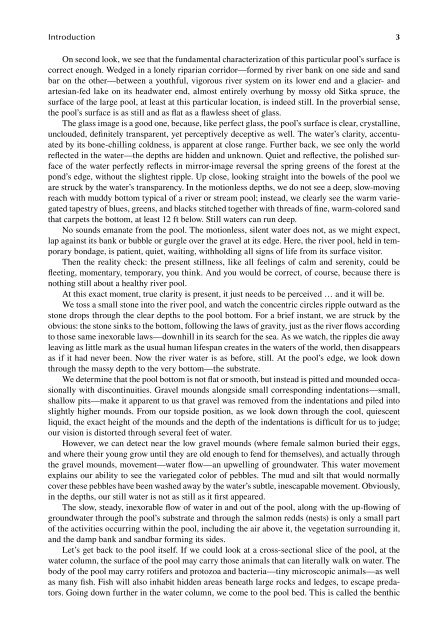Science of Water : Concepts and Applications
Science of Water : Concepts and Applications
Science of Water : Concepts and Applications
You also want an ePaper? Increase the reach of your titles
YUMPU automatically turns print PDFs into web optimized ePapers that Google loves.
Introduction 3<br />
On second look, we see that the fundamental characterization <strong>of</strong> this particular pool’s surface is<br />
correct enough. Wedged in a lonely riparian corridor—formed by river bank on one side <strong>and</strong> s<strong>and</strong><br />
bar on the other—between a youthful, vigorous river system on its lower end <strong>and</strong> a glacier- <strong>and</strong><br />
artesian-fed lake on its headwater end, almost entirely overhung by mossy old Sitka spruce, the<br />
surface <strong>of</strong> the large pool, at least at this particular location, is indeed still. In the proverbial sense,<br />
the pool’s surface is as still <strong>and</strong> as fl at as a fl awless sheet <strong>of</strong> glass.<br />
The glass image is a good one, because, like perfect glass, the pool’s surface is clear, crystalline,<br />
unclouded, defi nitely transparent, yet perceptively deceptive as well. The water’s clarity, accentuated<br />
by its bone-chilling coldness, is apparent at close range. Further back, we see only the world<br />
refl ected in the water—the depths are hidden <strong>and</strong> unknown. Quiet <strong>and</strong> refl ective, the polished surface<br />
<strong>of</strong> the water perfectly refl ects in mirror-image reversal the spring greens <strong>of</strong> the forest at the<br />
pond’s edge, without the slightest ripple. Up close, looking straight into the bowels <strong>of</strong> the pool we<br />
are struck by the water’s transparency. In the motionless depths, we do not see a deep, slow-moving<br />
reach with muddy bottom typical <strong>of</strong> a river or stream pool; instead, we clearly see the warm variegated<br />
tapestry <strong>of</strong> blues, greens, <strong>and</strong> blacks stitched together with threads <strong>of</strong> fi ne, warm-colored s<strong>and</strong><br />
that carpets the bottom, at least 12 ft below. Still waters can run deep.<br />
No sounds emanate from the pool. The motionless, silent water does not, as we might expect,<br />
lap against its bank or bubble or gurgle over the gravel at its edge. Here, the river pool, held in temporary<br />
bondage, is patient, quiet, waiting, withholding all signs <strong>of</strong> life from its surface visitor.<br />
Then the reality check: the present stillness, like all feelings <strong>of</strong> calm <strong>and</strong> serenity, could be<br />
fl eeting, momentary, temporary, you think. And you would be correct, <strong>of</strong> course, because there is<br />
nothing still about a healthy river pool.<br />
At this exact moment, true clarity is present, it just needs to be perceived … <strong>and</strong> it will be.<br />
We toss a small stone into the river pool, <strong>and</strong> watch the concentric circles ripple outward as the<br />
stone drops through the clear depths to the pool bottom. For a brief instant, we are struck by the<br />
obvious: the stone sinks to the bottom, following the laws <strong>of</strong> gravity, just as the river fl ows according<br />
to those same inexorable laws—downhill in its search for the sea. As we watch, the ripples die away<br />
leaving as little mark as the usual human lifespan creates in the waters <strong>of</strong> the world, then disappears<br />
as if it had never been. Now the river water is as before, still. At the pool’s edge, we look down<br />
through the massy depth to the very bottom—the substrate.<br />
We determine that the pool bottom is not fl at or smooth, but instead is pitted <strong>and</strong> mounded occasionally<br />
with discontinuities. Gravel mounds alongside small corresponding indentations—small,<br />
shallow pits—make it apparent to us that gravel was removed from the indentations <strong>and</strong> piled into<br />
slightly higher mounds. From our topside position, as we look down through the cool, quiescent<br />
liquid, the exact height <strong>of</strong> the mounds <strong>and</strong> the depth <strong>of</strong> the indentations is diffi cult for us to judge;<br />
our vision is distorted through several feet <strong>of</strong> water.<br />
However, we can detect near the low gravel mounds (where female salmon buried their eggs,<br />
<strong>and</strong> where their young grow until they are old enough to fend for themselves), <strong>and</strong> actually through<br />
the gravel mounds, movement—water fl ow—an upwelling <strong>of</strong> groundwater. This water movement<br />
explains our ability to see the variegated color <strong>of</strong> pebbles. The mud <strong>and</strong> silt that would normally<br />
cover these pebbles have been washed away by the water’s subtle, inescapable movement. Obviously,<br />
in the depths, our still water is not as still as it fi rst appeared.<br />
The slow, steady, inexorable fl ow <strong>of</strong> water in <strong>and</strong> out <strong>of</strong> the pool, along with the up-fl owing <strong>of</strong><br />
groundwater through the pool’s substrate <strong>and</strong> through the salmon redds (nests) is only a small part<br />
<strong>of</strong> the activities occurring within the pool, including the air above it, the vegetation surrounding it,<br />
<strong>and</strong> the damp bank <strong>and</strong> s<strong>and</strong>bar forming its sides.<br />
Let’s get back to the pool itself. If we could look at a cross-sectional slice <strong>of</strong> the pool, at the<br />
water column, the surface <strong>of</strong> the pool may carry those animals that can literally walk on water. The<br />
body <strong>of</strong> the pool may carry rotifers <strong>and</strong> protozoa <strong>and</strong> bacteria—tiny microscopic animals—as well<br />
as many fi sh. Fish will also inhabit hidden areas beneath large rocks <strong>and</strong> ledges, to escape predators.<br />
Going down further in the water column, we come to the pool bed. This is called the benthic






